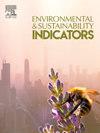Modeling habitat suitability for endangered herb (Salvia leriifolia Benth) using Innovative hybrid machine learning algorithms
IF 5.4
Q1 ENVIRONMENTAL SCIENCES
引用次数: 0
Abstract
Mapping habitat suitability is critical for conserving endangered medicinal and aromatic plants (MAPs) in degraded ecosystems. This study evaluated habitat suitability for Salvia leriifolia, an endangered herb in Khorasan Razavi, Iran, by comparing individual machine learning models (Random Forest [RF], Boosted Regression Tree [BRT], Generalized Linear Model [GLM]) with hybrid ensemble models (FDA-GLM-MDA and RF-CART-BRT). Using GIS, we compiled a dataset of 23 environmental and anthropogenic variables. Variable importance was assessed via Elastic Net (ENET), while model performance was evaluated using ROC-AUC metrics. Results identified distance from roads, calcium (Ca), organic matter (OM), and potassium (K) as the most influential predictors of habitat suitability. The individual RF model (AUC = 0.983) and hybrid RF-CART-BRT model (AUC = 0.970) demonstrated the highest predictive accuracy, underscoring the efficacy of tree-based and ensemble approaches in ecological modeling. However, while high-accuracy models offer precise predictions, their complexity may challenge practical application by conservation practitioners. This highlights the need to balance technical precision with operational feasibility in conservation planning. Although focused on Khorasan Razavi, the methodology is transferable to regions facing similar ecological pressures. By identifying key drivers of habitat suitability, this work enabled scalable strategies for protecting endangered MAPs. These insights offered actionable strategies for resource managers and agricultural planners to sustainably protect and cultivate S. leriifolia, while addressing predictive model implementation challenges.
利用创新的混合机器学习算法建模濒危草本植物(鼠尾草)的栖息地适宜性
生境适宜性制图对于保护退化生态系统中濒危药用和芳香植物至关重要。本研究通过比较单个机器学习模型(随机森林[RF]、增强回归树[BRT]、广义线性模型[GLM])和混合集成模型(FDA-GLM-MDA和RF- cart -BRT),评估了伊朗呼罗桑Razavi地区濒危草本植物丹参(Salvia leriifolia)的生境适宜性。利用地理信息系统,我们编制了一个包含23个环境和人为变量的数据集。变量重要性通过弹性网(ENET)进行评估,而模型性能使用ROC-AUC指标进行评估。结果表明,与道路的距离、钙(Ca)、有机质(OM)和钾(K)是影响生境适宜性的主要预测因子。单个RF模型(AUC = 0.983)和混合RF- cart - brt模型(AUC = 0.970)的预测精度最高,表明基于树的方法和集成方法在生态建模中的有效性。然而,尽管高精度模型提供了精确的预测,但它们的复杂性可能会挑战保护从业者的实际应用。这突出了在保护规划中平衡技术精确性和操作可行性的必要性。虽然该方法关注的是呼罗珊·拉扎维,但它也适用于面临类似生态压力的地区。通过确定生境适宜性的关键驱动因素,这项工作为保护濒危map提供了可扩展的策略。这些见解为资源管理者和农业规划者提供了可操作的策略,以可持续地保护和培育野藿香,同时解决预测模型实施的挑战。
本文章由计算机程序翻译,如有差异,请以英文原文为准。
求助全文
约1分钟内获得全文
求助全文
来源期刊

Environmental and Sustainability Indicators
Environmental Science-Environmental Science (miscellaneous)
CiteScore
7.80
自引率
2.30%
发文量
49
审稿时长
57 days
 求助内容:
求助内容: 应助结果提醒方式:
应助结果提醒方式:


